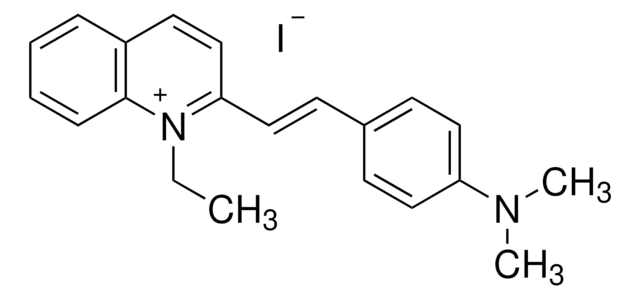1.02282
Quinaldine red
pH indicator, Reag. Ph Eur
Synonyme(s) :
Quinaldine red
About This Item
Produits recommandés
product name
Quinaldine red, indicator Reag. Ph Eur
Agence
reag. Ph. Eur.
Niveau de qualité
Forme
solid
Impuretés
≤5% Water (Karl Fischer)
visual transition interval
1.4-3.2, colorless to red
Pf
240 °C (decomposition)
Masse volumique apparente
290 kg/m3
λmax
528-533 nm in acetic acid
Température de stockage
2-30°C
InChI
1S/C21H23N2.HI/c1-4-23-20(16-12-18-7-5-6-8-21(18)23)15-11-17-9-13-19(14-10-17)22(2)3;/h5-16H,4H2,1-3H3;1H/q+1;/p-1
Clé InChI
JOLANDVPGMEGLK-UHFFFAOYSA-M
Catégories apparentées
Application
- Quinaldine Red as a fluorescent probe for determining the melting temperature (T(m)) of proteins: a simple, rapid and high-throughput assay.: This study presents Quinaldine Red as an effective fluorescent probe for determining the melting temperatures of proteins, offering a rapid and high-throughput method suitable for broad applications in biochemical research (Das et al., 2024).
- Red emitting fluorogenic dye as an efficient turn-on probe for milk allergen.: Explores the use of a red-emitting fluorogenic dye, likely involving Quinaldine Red, as a turn-on probe for detecting milk allergens, highlighting its potential in food safety and allergen detection (Chakraborty, 2022).
- A rapid, naked-eye detection of hypochlorite and bisulfite using a robust and highly-photostable indicator dye Quinaldine Red in aqueous medium.: Describes the application of Quinaldine Red for the visual detection of chemicals like hypochlorite and bisulfite, underlining its utility in environmental monitoring and chemical safety (Dutta et al., 2018).
- Self-Assembly and Formation of Chromonic Liquid Crystals from the Dyes Quinaldine Red Acetate and Pyronin Y.: Investigates the self-assembly properties of Quinaldine Red and its application in forming chromonic liquid crystals, demonstrating its potential in material science and nanotechnology (Magana et al., 2016).
Remarque sur l'analyse
Transition range: pH 1.4 - pH 3.2 colourless - red
Absorption maximum λmax. (Acetic acid): 528 - 533 nm
Spec. Absorptivity A 1%/1cm (λmax; 0.005 g/l; acetic acid glacial; calculated on anhydrous substance): 1150 - 1480
Water (according to Karl Fischer): ≤ 5 %
Code de la classe de stockage
11 - Combustible Solids
Classe de danger pour l'eau (WGK)
WGK 3
Point d'éclair (°F)
Not applicable
Point d'éclair (°C)
Not applicable
Certificats d'analyse (COA)
Recherchez un Certificats d'analyse (COA) en saisissant le numéro de lot du produit. Les numéros de lot figurent sur l'étiquette du produit après les mots "Lot" ou "Batch".
Déjà en possession de ce produit ?
Retrouvez la documentation relative aux produits que vous avez récemment achetés dans la Bibliothèque de documents.
Notre équipe de scientifiques dispose d'une expérience dans tous les secteurs de la recherche, notamment en sciences de la vie, science des matériaux, synthèse chimique, chromatographie, analyse et dans de nombreux autres domaines..
Contacter notre Service technique





